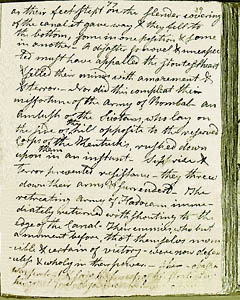
THE WRITINGS OF REV. SOLOMON SPALDING |
|
Known Manuscripts: -- Oberlin MS --
|

|
|
According to his widow, Solomon Spalding was a keen student of the classics. He read the great stories of Greece and Rome and knew their histories. He could probably quote passages in both Homer and Virgil from memory. But the Rev. Solomon Spalding was also an adopted son of the Ohio Western Reserve and it must have worried him greatly that Frontier America had no epic histories of her own: no Iroquois "Iliad," no Delaware "Aeneid," not even a Buckeye "Poems of Ossian" to recount the forgotten heroism of the long-lost "Mound-Builders." In about 1812 Solomon Spalding set out to remedy that defect in American history and literature. He may have been spurred on by reading Robert Southey's "Madoc" poetry. But the picture of Britannic adventurers fighting heroic wars with the ancient Aztecs was hardly what patriot Spalding had in his mind in the midst of the War of 1812. His epic would be wholly an American one -- a thick stack of prose that would leave the credulous frontiersmen rubbing their eyes in wonder. He set out to write the American narrative equivalent of what James MacPherson had done for Scotland. Since no prehistoric epic of the first Americans existed, he would fabricate one himself. There is good reason to believe that Spalding wrote an epic story of the Ten "Lost" Tribes of Israel and how they wandered across Asia to finally settle in ancient America and become its first inhabitants. I have already provided my thoughts on why I think that Spalding wrote such a pseudo-history and I will not go into detail discussing that subject here. Some people believe that Spalding also wrote the precursor to the Book of Mormon -- another would-be epic American story. If he did in fact produce such a story, it was probably a revision of what I conjecture was his original Lost Tribes tale. Those who can see the hand of Spalding in the text of the Book of Mormon may well imagine how it could have been written as a Redman's Ossian and the Book of Joshua all rolled into one. The only surviving Spalding pseudo-history is the sketchy, unfinished story now on file in the Archives of Oberlin College. At the very best, that novelette can only be termed a concept paper for a would-be epic; but as mock-epic it succeeds rather well. While it is no "Rape of the Lock," the Oberlin story is indeed the "charming story in its own right" described by Kent P. Jackson. The wry (and dry) humor and parody sometimes calls for a second (or even a third) perusal before the modern reader "gets it" and Spalding's socio-religious jokes come through intelligibly. But as true epic the Oberlin story never gets off the ground -- not even as a pen sketch of some projected lengthy adventure. True epic spans vast vistas in time and space, recounting the birth and progress of whole nations in heroic meter or rosy prose. The true heroes and heroines sacrifice their all to propagate and protect the tribe, the people, the nation. They rise above mundane humanity to grasp into the starry heavens or to overcome the chaos of the infernal pit. They elevate and enoble the people in ways Spalding never seemed to have comprehended. And, like the story told in the Oberlin fragment, the accounts related in the Book of Mormon also fall short of true heroic epic. It is easy to imagine a common author for both -- an author emulating MacPherson's Ossianic shadows instead of the full vigor and substance of a Ramayana, an Iliad, or an Aeneid. Dale R. Broadhurst |
|
Return to Top of Page Return to: Spalding Studies "Home" | Spalding Studies "Library" | "Special Collections" Last Revised: 10-23-2000 |